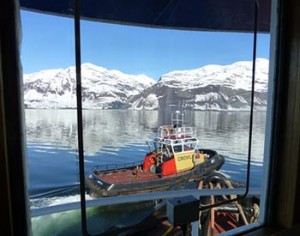
On a recent morning, the tug Stalwart pulled away from the SERVS dock, headed out to meet the tanker Alaska Legend as it entered Port Valdez. A dense fog hung over the port and every few minutes, fog horns called out in the distance.
Looking out at the pea-soup, Captain David Sweeney remarked that he’d take his time crossing the bay.
“We’re not in a rush, and it’s a good idea to slow down in the fog.”
Much has been written about the five world-class and purpose-built escort tugs in Prince William Sound, owned by Crowley and under contract to SERVS. With 10,192 horsepower engines and rapid response capabilities, these vessels are the show horses of SERVS’ fleet, and rightfully so. Introduced in 1999 and 2000, the three Prevention and Response Tugs (PRTs) and the two Enhanced Tractor Tugs (ETTs) have revolutionized tanker escorts in the Sound.
But there are other tugs in Valdez, like the Invader-class Stalwart, that support SERVS’ mission as well. They are also owned by Crowley and move response barges and personnel as needed. And, like today, they help tankers safely dock at the Valdez Marine Terminal.
Docking a tanker is a routine job for one of these tugs. “Pretty simple if you know how to do it,” said Sweeney, as he pulled up alongside the Legend. “A little challenging for a new captain.”
Two or three tugs move into position alongside a tanker, as directed by a pilot on the bridge of the larger vessel. The number of tugs and their position can depend on the size of the tanker, the weather and the preferences of the pilot.
For this docking, the Stalwart is located near the starboard bow of the Legend. The fog has already burned off, and we can see the tug Bulwark at mid-ship and the Alert aft. Crews from the tanker throw messenger lines from above, eventually leading larger working lines -the circumference of a baseball- through the bullring on the bow before it is made up on deck. The Legend is going to berth on its port side, requiring a U-Turn up Port Valdez. The tugs are along for the ride as the tanker glides past the Terminal, but as the vessel begins to make its right-hand turn, the tugs’ engines engage.
“Right now, the engines aren’t really pulling or pushing, they’re kind of twisting the tanker into place,” explains Sweeney.
Soon enough, the tanker nears the berth. Over the radio, a calm voice offers a slew of directions for each tug. “Bulwark, touch down,” (get ready to push) “Alert, push,” “Stalwart, stretch” (get ready to pull) “Stalwart, back” (pull). Slowly and noisily, the tanker gets nudged and tugged into place.
Captain Sweeney directs the Stalwart’s line boats, the Gus-E and Roger to tie up the lines to the mooring dolphins at the berth. Soon, a SERVS boom boat will appear to encircle the tanker with boom before it can load crude oil.
“Thanks, gentlemen,” a voice comes through on the radio. It’s the pilot. “That was fun.”
• Submitted by Alyeska Communications.